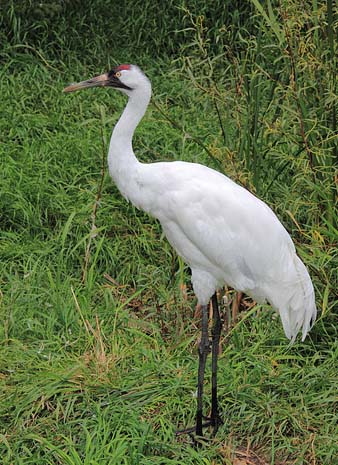Some of the most popular winter residents of the Texas coast start heading north around the middle of March. But thanks to a lot of T-L-C, they’ll be back by early fall -- and in larger numbers every yearThe visitors are whooping cranes -- the tallest birds in North America. They stand up to five feet high, with wings that span more than seven feet. Their bodies are white, with black trim on their wingtips and legs, and a red patch atop their heads.
 Whooping crane. Credit: Wikipedia.
Whooping crane. Credit: Wikipedia.During the winter, they live on the coastal wetlands near Rockport, Texas, mainly on the Aransas National Wildlife Refuge. They use their long bills to probe for crabs and clams, although they also eat other small critters, along with berries.
In the spring, they migrate 2400 miles to Canada’s Northwest Territories, where they lay their eggs and raise the hatchlings -- usually one per family. And at summer’s end, they head back to Texas. They travel in family groups, and the youngsters stay with mom and dad for the first winter. After that, they usually take up feeding grounds close to their parents.
Whooping cranes once roamed North America by the thousands. By 1941, though, only 16 of these birds remained -- all of them in the group that wintered in Texas. Thanks to a massive conservation effort, though, the group’s numbers have swelled to almost 300.
Even so, scientists are trying to create a second population of migrating whooping cranes to ensure that the species won’t fall prey to a hurricane or other catastrophe. More about that on our next program.

